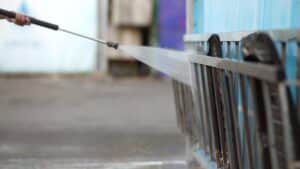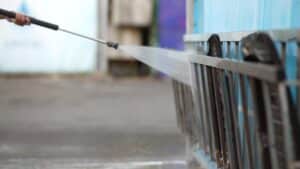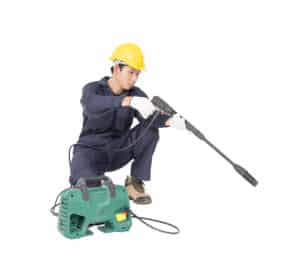Can I use my pressure washer to clean vinyl siding?
Key Takeaways
- It is safe and effective to use a pressure washer to clean vinyl siding.
- Using the proper pressure level, nozzles, and techniques is crucial to prevent damage to the siding.
- Best practices for cleaning vinyl siding include inspecting the exterior, using the right pressure and nozzle, starting from a safe distance, avoiding spraying certain areas, using an environmentally friendly cleaning solution, working from bottom to top, letting the cleaning solution sit, and prioritizing safety.
Yes, you can use a pressure washer to clean vinyl siding. It is a safe and effective method for removing dirt, grime, and stains from your home’s exterior. However, it is important to use the proper pressure level, nozzles, and techniques to prevent any damage to the vinyl siding.
Understanding the Basics
Before you start pressure washing your vinyl siding, it is important to understand the basics of using a pressure washer. The pressure level and nozzle you use are crucial in determining the effectiveness and safety of the cleaning process.
According to Mr. Handyman, it is recommended to start with a low pressure setting and gradually increase if needed. This helps to ensure that you do not apply too much pressure that can cause damage to the siding. Additionally, using the appropriate nozzle is important. White or green nozzles are designed for softer surfaces like vinyl siding, while red or yellow nozzles are more powerful and should be avoided for siding cleaning.
Best Practices for Cleaning Vinyl Siding
To clean your vinyl siding effectively and safely, it is important to follow some best practices. The following tips are gathered from various sources:
1. Inspect Your Home’s Exterior
Before starting the pressure washing process, it is recommended to carefully inspect your home’s exterior for any cracks or damage. This allows you to identify areas that may need special attention or repair.
2. Use the Right Pressure and Nozzle
As mentioned earlier, using the proper pressure level and nozzle is crucial. Start with a low pressure setting and gradually increase if needed. Use white or green nozzles specifically designed for vinyl siding to minimize the risk of damage.
3. Start from a Safe Distance
When you begin pressure washing, start from a safe distance of at least 3 feet away from the siding. Gradually move closer, ensuring that you are not using excessive pressure that can cause damage.
4. Avoid Spraying Certain Areas
While pressure washing, it is important to avoid spraying windows, window screens, outdoor lights, screen doors, and painted surfaces. These areas may be more sensitive to the high pressure and can be damaged easily.
5. Use an Environmentally Friendly Cleaning Solution
Using a cleaning solution can enhance the effectiveness of pressure washing. It is recommended to use an environmentally friendly cleaning concentrate that is safe for siding, landscapes, windows, and sidewalks. You can dilute it with water and use a chemical/detergent injector if available.
6. Work from Bottom to Top
To prevent streaking, it is advised to start spraying from the bottom and work your way up. This ensures that any cleaning solution or dirt is washed off effectively without leaving behind streaks or residue.
7. Let the Cleaning Solution Sit
Allow the cleaning solution to sit on the siding for 5-10 minutes before rinsing it off. This gives the solution enough time to loosen and dissolve any stubborn dirt or stains.
8. Safety First
When operating a pressure washer, it is important to prioritize safety. Stand at least 3 feet away from the area being sprayed, wear safety glasses to protect your eyes, and follow the manufacturer’s instructions for proper operation.
Expert Opinions
According to This Old House, using a power washer correctly can keep your home looking fresh and clean. They advise beginners to use the tip with the widest angle to minimize the risk of damaging the siding. The article also mentions that power washing can be dangerous if done incorrectly, so caution is urged when using a power washer.
Conclusion
In conclusion, it is safe to use a pressure washer to clean vinyl siding as long as you follow the best practices mentioned above. Using the proper pressure level, nozzles, and techniques will ensure effective cleaning without causing any damage to the siding. Remember to conduct a thorough inspection, use an environmentally friendly cleaning solution, and prioritize safety while operating the pressure washer.
Related Websites:
FAQs:
Q: Can a pressure washer be used on vinyl siding?
Yes, a pressure washer can be used on vinyl siding. However, it is important to use the right techniques and settings to prevent damage. Low-pressure washing and following recommended guidelines can ensure safe and effective cleaning.
Q: What are the potential risks of using a pressure washer on vinyl siding?
Using a pressure washer on vinyl siding without proper techniques can cause damage such as cracks, chipping, or water penetration. High-pressure settings or incorrect angles can also lead to the removal of paint or loosening of siding panels.
Q: What are the safe cleaning methods for vinyl siding?
There are two safe cleaning methods for vinyl siding. Manual cleaning techniques involve using tools like soft brushes, mild cleaners, and a water hose. Low-pressure washing, using a pressure washer with appropriate nozzle settings and keeping a safe distance from the siding, is also effective while minimizing the risk of damage.
Q: What are some maintenance tips for vinyl siding?
Regular inspection and cleaning routines are important for maintaining vinyl siding. Additionally, taking preventive measures like trimming vegetation near the siding and keeping gutters clean can protect against potential damage. If necessary, professional cleaning services can be recommended to ensure thorough and safe cleaning.
Q: Why is proper vinyl siding cleaning important?
Proper vinyl siding cleaning helps maintain its appearance, prolong its lifespan, and prevent issues like mold or mildew growth. Regular cleaning also ensures that the siding continues to provide insulation and protection to the underlying structure.






